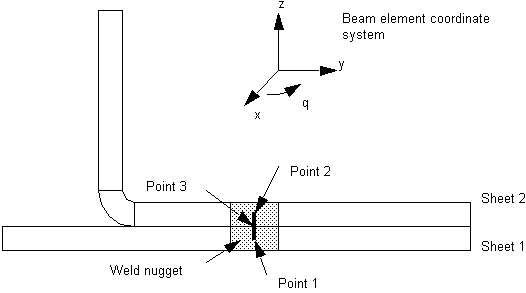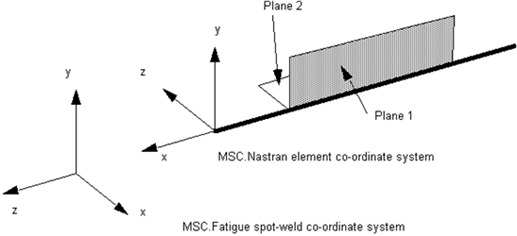XXXXXXXXXXXXXXXXXXXXXXXXXXXXXXXXXXXXXXXXXXXXXXXXXXXXXXXXXXXXXXXXXXXXXXXXXXXXXXXXXXXXXXXXXXXXXXXXXXXXXXXXXXXXXXXXXXXXXXXXXXXXXXXXXXXXXXXXXXXXXXXXXXXXXXXX''"> Introduction
SPOTW is a specialized MSC.Fatigue module that analyzes the fatigue life of spot welds using the S-N method. Theoretical background can be found in
Spot Weld Analysis Theory, 793 in this chapter.
In setting up a proper spot weld analysis it is important to first have a sound understanding of the operation of MSC.Fatigue within the MSC.Patran environment or within MSC.Fatigue Pre & Post. It is suggested that you first read and understand
Using MSC Fatigue (Ch. 2). Job setup for a spot weld analysis is very similar to a job setup for other fatigue analysis types with only a few differences, as pointed out in this chapter.
Certain limitations or restraints exist in setting up a spot weld analysis. These are mainly the fact that the analysis MUST be set up within a preprocessor, and that only results from MSC.Nastran bar elements representing the spot welds can be used.
The method requires spot welds to be modeled as stiff MSC.Nastran beam elements. The forces transmitted through these beam elements are used to calculate the structural (nominal) stresses in the weld nugget and the adjoining sheet metal at intervals around the perimeter of the nugget. These stresses can then be used to make fatigue life predictions on the spot weld using a S-N (total life) method.
Figure 9‑1 Schematic of Typical Spot Weld
In a finite element analysis, the weld is modeled in MSC.Nastran as a stiff beam element joining the mid-plane of two sheets. The length of the beam element should be 0.5(s1+s2) where s1 and s2 are the thicknesses of sheets 1 and 2 respectively. Point 3 is on the axis of the weld nugget and at the interface of the 2 sheets, i.e. 0.5s1 from Point 1. All forces and moments are taken to be in the MSC.Fatigue beam element coordinate system. This is taken to be a Cartesian system with the Z axis going from Point 1 to Point 2. The forces and moments at points 1 and 2 will be those applied by the spot welds on the sheets, and the forces and moments at point 3 will be those applied by the upper section (between point 3 and point 2) on the lower section (between point 1 and point 3).
Figure 9‑2 Relationship of MSC.Fatigue Spot Weld Coordinate System to MSC.Nastran
The important thing here is to know how the MSC.Nastran beam element coordinate system relates to that used in the new spot weld calculation software, and how the results in MSC.Nastran translate to those required by the fatigue analysis tool. The relationship between the coordinate systems is shown above. The MSC.Nastran beam element has positive X direction from Point A to Point B. In MSC.Fatigue Point A is Point 1 and Point B is Point 2. The positive Z direction in MSC.Fatigue is the positive X direction in MSC.Nastran. The Y axes are the same in both coordinate systems. The required transformations are built into the PAT3FAT translator.
In addition, if the two plates are dissimilar in material or thickness, the spot welds in each group should all have the same directionality - with the axis of the beams going from Sheet 1 to Sheet 2. The directions of beam elements can be checked and reversed using one of the MSC.Patran utilities.
Some items of note with this spot weld analyzer are:
1. You must use a preprocessor such as MSC.Patran to create the spot welds on your FE mesh. MSC.Fatigue does not provide any modeling tools to help in the creation of these spot welds.
2. Very stiff MSC.Nastran beam or bar elements (CBAR) must be used to model the spot welds. The analysis results must be from a MSC.Nastran analysis, specifically bar forces and moments.
3. The spot welds (bars/beams) must be perpendicular to the two sheets. If not, errors may occur because the bending moments will not be correct.
4. You do not need to define the radius of the spot weld nugget in the beam itself. The actual cross section of the beam is unimportant, but it should be stiff in relation to the surrounding shells. The compliance of the joint comes from the shell elements. Torsional stiffness is normally set to zero.
CWELD Modeling
Refer to the NASTRAN Users Guide for modeling CWELDS.
MSC.Fatigue supports results from all CWELD modeling optioins - ELPAT, ELEMID, GRIDID, ALIGN and PALTPAT.


